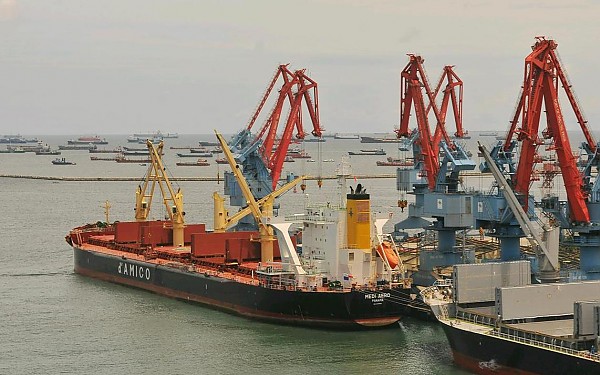Economists have raised the alarm on the weakening growth momentum of the Korean economy, calling on the government to take steps to prevent the country from being stuck in a prolonged slowdown.
Local research institutes predict that Asia’s fourth-largest economy will next year expand at a slower pace than its annual potential growth rate, which is estimated by the Bank of Korea to be around 2.8-2.9 percent. The potential growth rate refers to the maximum growth an economy could achieve through the input of all factors of production without prompting inflation.
In their reports released last month, the LG Economic Research Institute and the Hyundai Research Institute predicted that the country’s economy would grow 2.5 percent and 2.6 percent next year, respectively.
The two private think tanks cited slumping exports and declining investment as the main reasons for their forecast that Korea’s economic growth will continue to decelerate.
Both the government and the central bank project the economy will grow 2.8 percent in 2019.
Local research institutes are also skeptical about the possibility of Korea’s economy expanding 2.9 percent this year, as forecast by government and BOK policymakers, following 3.1 percent growth last year.
International economic organizations have become less optimistic about the Korean economy.
In its latest global economic outlook report released last month, the Organization for Economic Cooperation and Development revised down its 2018 growth forecast for Korea to 2.7 percent from its previous estimate of 3 percent. In contrast, the Paris-based organization kept this year’s growth outlook for the US, China and Japan unchanged at 2.9 percent, 6.7 percent and 1.2 percent, respectively. The average growth forecast for 20 major economies addressed in the OECD report was adjusted down slightly to 3.9 percent from 4 percent.
The Korean economy has been increasingly sidelined from the global economic recovery this year.
Its on-quarter real growth rate of 0.6 percent for April-June was below the figures for the US, China and Japan, which reached 1 percent, 1.8 percent and 0.7 percent, respectively, according to OECD data. The average for the 20 major economies stood at 1 percent.
Furthermore, economists say the Korean economy is beginning to enter an L-shaped long-term slump.
“There is a rising possibility that growth below the country’s growth potential will be protracted,” said Kim Tae-gi, an economics professor at Dankook University.
However, government officials disagree with the view that the economy is slowing down.
A monthly report published by the Ministry of Economy and Finance has insisted the economy has been on track to recovery for the past 10 consecutive months.
Economists urge the government to depart from its optimistic outlook that contradicts downward indicators and make changes to its policies that they say have been sapping economic vitality.
The HRI report forecast that the increase in the country’s exports, which have shored up its economy amid sluggish domestic demand, would decelerate from 7.2 percent this year to 4.4 percent next year.
With global demand for semiconductors, which account for nearly a quarter of Korea’s outbound shipments, expected to weaken in the coming years, the country’s carmakers could be hit harder by a possible US tariff on auto imports than their foreign competitors.
A slump in exports would further drag down domestic facility investment, which decreased for six consecutive months in August. The LGERI report predicted facility investment would contract 2 percent next year, compared with an estimated 1.2 percent reduction this year.
The rate of growth in domestic consumption is estimated to slide from 3.2 percent in 2018 to 3 percent in 2019, according to the state-run Korea Development Institute.
The BOK’s possible interest rate hike this month to reduce the widening rate gap with the US would result in weakening consumption spending and corporate investment.
Experts say regulatory reforms should be accelerated to help galvanize corporate activity and carry forward innovation-driven growth needed to strengthen the country’s industrial competitiveness.
They indicate a set of labor-friendly measures taken by President Moon Jae-in’s administration as part of its income-led growth policy have been undermining growth momentum by imposing heavier burdens on companies.
“It’s only natural for the economy to lose vitality in the worsening environment surrounding private companies that should take the lead in boosting investment and creating jobs,” said Hong Sung-il, an analyst at the Korea Economic Research Institute, a private think tank.
Economists contrast Korea’s lackluster economic performance particularly with the robust growth in the US economy bolstered by President Donald Trump’s pro-corporate measures such as tax cuts and deregulation.
The world’s largest economy is projected by the US Federal Reserve to grow 3.1 percent this year. It would mark the first reversal of growth rates between the US and Korea since 1998, when the Korean economy contracted 6.9 percent amid a foreign exchange crisis while the US recorded a 4.5 percent growth.
The US unemployment rate fell from 3.9 percent in August to 3.7 percent in September, the lowest since 1969, as employers added 134,000 jobs, according to the US Labor Department.
In contrast, Korea’s jobless rate rose 0.4 percentage point to 4 percent in August with the number of employed people increasing by a meager 3,000. Official data to be released later this week are expected to show the job situation worsened in September.
By Kim Kyung-ho
([email protected])


